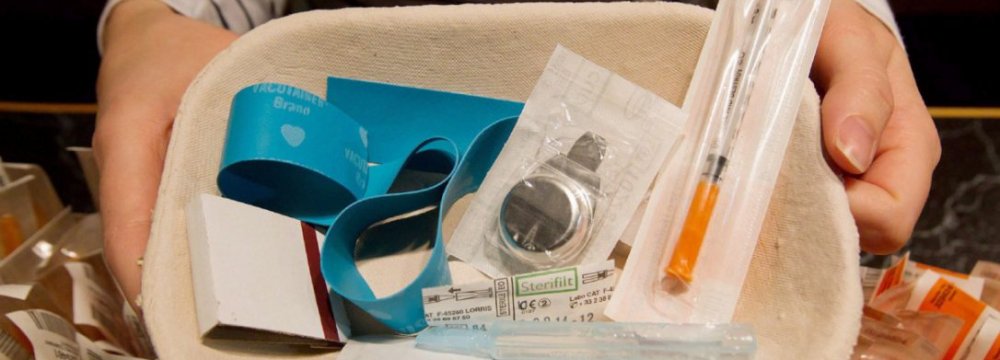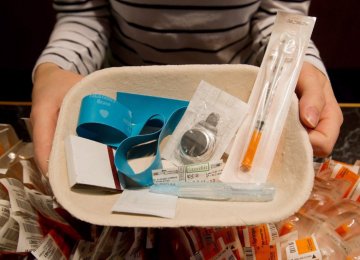The plan to open supervised injection sites (SIS) for drug addicts was approved by the Iranian Drug Control Headquarters (IDCH) and will soon be piloted in Kerman and Khuzestan provinces.
The SIS are legally-sanctioned, medically-supervised facilities designed to reduce public nuisance from drug users and provide a hygienic and stress-free environment for addicts to use illicit drugs intravenously.
Advocates of the plan assert that sanctioning such sites does not mean approval of substance use but aims to control drug addicts’ risky behavior which can have devastating effects on them as well as their communities.
“This is to prevent injection drug users (IDUs) from infections with viruses like HIV or hepatitis through needles, and transmission of the diseases to other addicts,” said Parviz Afshar, IDCH spokesman and deputy head, as reported by the Persian language newspaper ‘Iran.’
Although the reasons for such proposals are sound, there are still challenges and the local authorities need to justify fully that the SIS will help reduce the serious health problems and mortality rates among drug addicts.
In response to whether or not substance users will be supplied with narcotics, Afshar said that this matter will be discussed at a later stage and provincial officials would be given full authority to make decisions.
The launch of the safe injection sites is in line with policies to reduce the consequences of drug abuse.
All Possible Means
The top priority, however, is to control the distribution of illicit drugs and reduce their availability in the market in order to prevent addiction. The next step is to treat the addicts by whatever means possible.
A number of measures also focus on rehab of drug addicts, especially those who respond to treatment and are able to sustain it.
Harm reduction includes post-remedial support to prevent relapse. Measures in this regard include medical treatment with buprenorphine, opium tincture or methadone and empowerment through jobs and social support.
However, there are a number of drug users who are difficult or sometimes impossible to cure. They frequently relapse into substance abuse even after rehabilitation, and medication is ineffective. These “failures” often end up as strays on city streets and can cause serious harm and pose a threat to the entire society.
Treating wounds due to overuse of injections, education and counseling, distribution of hygienic syringes and needles and establishing drop-in centers for drug users are among the measures to reduce the potential harms caused by addicts for whom there is always a small hope of recovery.
“Harm reduction programs which have been expanded in Iran since 2000, have miraculously reduced the rates of HIV and AIDS among IDUs,” said Afshar.
In 2004, out of the total number of diagnosed HIV-positive addicts, 65% had been infected via shared syringes while currently the rate has dropped to less than 40% which indicates the necessity of the programs.
Several countries have already practiced the idea and launched centers for “managed drug use” or “safe injection” where advanced addicts can have uninfected injection. The plan has attained success based on the statistics.
“Since Iran is a leading country with regard to reducing addiction harm, the idea of safe injection facilities was put forward, and will hopefully be implemented nationwide after approval by the competent authorities, said Afshar.
Substance Abuse Management Center
Meanwhile, the IDCH has plans to set up a ‘Substance Abuse Management Center’.
“The project is in line with the general policies issued by the Leader Ayatollah Seyyed Ali Khamenei, and will be supervised by the Expediency Council’s Committee for Combating Narcotics as the strategic monitoring body of the IDCH,” wrote Ali Hashemi, chair of the committee in the Persian language daily ‘Etemad’ on Sunday.
Details regarding the center’s mandate have not yet emerged but setting up safe injection sites and supervising substance abuse are part of its functions.
The global strategy of substance abuse management for the first time in the country has been placed on the radar of the next five-year economic development plan (2016-2021) and the three government branches have been assigned pertinent tasks in this regard, Hashemi said.
“The programs target harm reduction in drug abuse. Basically any step in the direction of guiding drug addicts toward substance abuse management, from addiction treatment to safe injecting rooms, empowering families, or creating jobs for the recovering addicts, all will be a hard blow on the lucrative trade of drug mafias; a progressive step that will impact the society on small and large scales,” Hashemi said.
Based on IDCH estimates in 2004, the national economy suffers a 450,000-billion-rials ($13 billion) loss annually due to the drug problem, directly and indirectly.
“The figure has not been updated since, but even going by those statistics, the nation is losing 1,100 billion rials ($315 million) a day to the scourge.”
The IDCH aims to reduce the growing number of new drug addicts by 25% by 2021 (5% per year) for five consecutive years. The target has been approved by the Majlis (parliament) and incorporated in the FYDP; however, Interior Minister and IDCH head Abdolreza Rahmani Fazli said last month that the country is lagging behind in reaching those targets.
According to Hashemi, any measure that could save even 5% of the annual economic losses due to the drug problem, and any plan that can reduce the addicted stratum by 5% per year, is a huge step.





